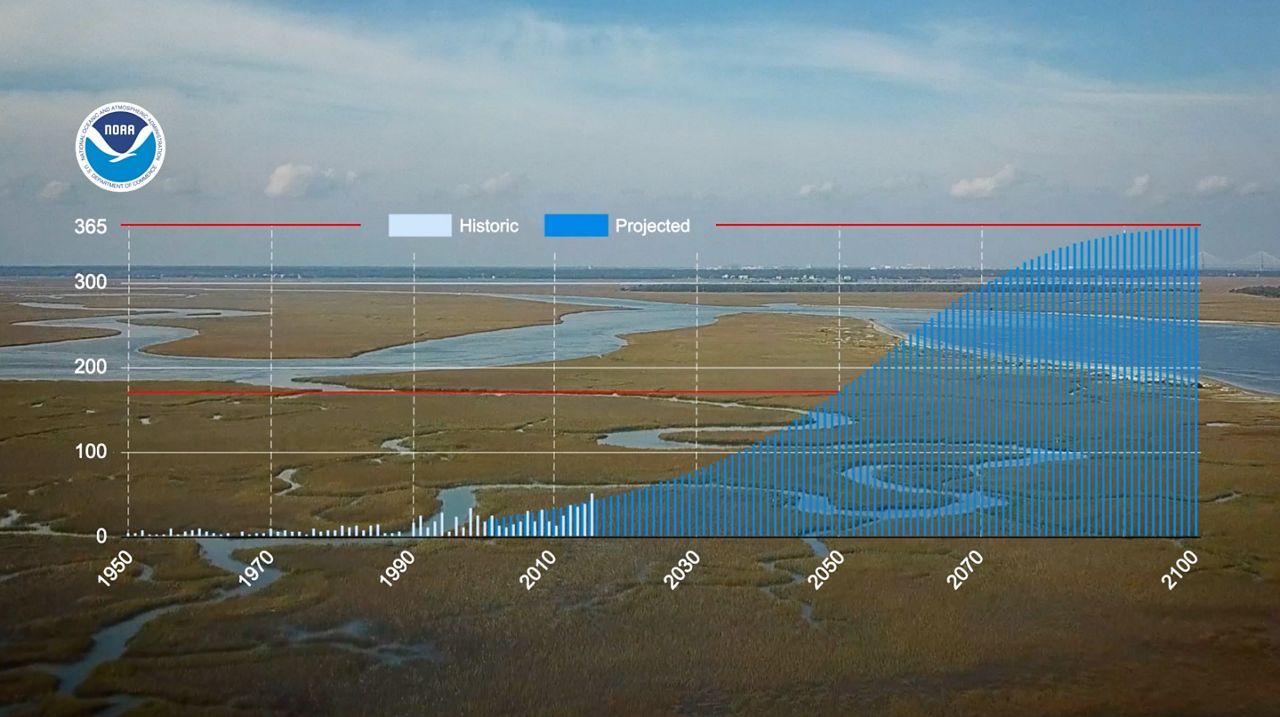Climate experts say a new government report that cautions record high sea level rise in the coming years is precise enough that communities should use it as a tool to adapt now, in order to prevent the worst impacts of increased flooding in the coming decades.
Water levels along the U.S. coast are expected to increase by nearly 10 to 12 inches on average by 2050, according to a new report produced by a federal sea level rise task force and released this month.
The technical report — led by the National Oceanic and Atmospheric Administration — uses “multiple lines of evidence” to lay out the clearest prediction yet about what Americans in coastal communities should expect to see over the next 30 years, regardless of changes in greenhouse gas emissions.
“It brings it very local, into a context of weather-related forecasting that folks use when they go outside. Should I bring an umbrella? Do I evacuate? It's the same set of criteria that we are now applying to sea level rise,” said William Sweet, an oceanographer and lead author of the report, which replaced 2017 estimates.
The new calculations show that the amount of sea level rise expected by 2050 is the same amount the country has seen in the last 100 years.

Nearly 40% of the U.S. population lives in a coastal area, according to NOAA, and the east and Gulf coasts are expected to see the biggest increases.
“It doesn't take a magic ball, really, to say what is going to be the impact of the sea level rise. We see it now,” Sweet said. “We can give maps to give folks a sense of what is to be expected.”
The report is not meant to be dire, he added, but instead be used as critical information for local and state officials.
Clearwater, Fl., for example, which sits on Florida’s Gulf coast, is expected to see more than 1.2 feet of sea level rise by 2060 even by NOAA’s lowest estimate. Cape Hatteras, N.C. is expected to see a 1.5 foot rise by then, with about the same predicted in lower Manhattan, New York City.
“It’s really understanding what's in harm's way now,” Sweet added. “A holistic approach can be taken in these communities to upgrade stormwater systems, to protect against the most vulnerable areas, to relocate when there's that option.”
NOAA’s report predicts flooding events will become worse and happen more often, even on sunny days due to high tides and winds combining with the higher water level.
Minor high-tide flooding will occur more than ten times per year on average, the report found, up from three times per year in 2020.
And moderate, likely-damaging flooding — which is defined as when water reaches streets and buildings near the source — will happen ten times as often by 2050: from 0.3 events annually to four.
“That is catastrophic for coastal communities that are already going through everything, because climate change only exacerbates every existing stressor that is in place,” said Jasmine Sanders, executive director of Our Climate. “That's from a health standpoint, a financial standpoint, migration flows to sociocultural and racial tensions.”
The NOAA report predicts another foot of sea level rise from 2050 to 2100 if greenhouse gas emissions keep rising at similar rates, though the most extreme estimates can still be avoided if emissions are addressed.
The Biden administration’s proposed climate plan is on hold as Democrats iron out the rest of the president’s agenda into legislation.
The White House spokeswoman responded to the new sea level report by emphasizing the president’s awareness about the issue.
“One in three Americans live in a county hit by a weather disaster this past year, which is a pretty startling statistic. And last year, extreme weather cost America $99 billion,” White House press secretary Jen Psaki said. “Certainly this report is further evidence of that.”
Psaki pointed to the $47 billion in the bipartisan infrastructure law for climate resilience, and she said the administration would continue to push for a broader climate effort.
Still, Sanders said resources need to go beyond funding to make comprehensive change.
“It’s not just money, but it’s the technical expertise. It's making sure that there's a sustainable implementation pathway,” she said. “You have to bring the community in from the get-go. Let them talk to you about what the problem is because they know.”
And the entire country will feel the effects if coastal communities start to falter, Sweet said, since the majority of the nation’s goods flow from the coast — a pandemic lesson learned as goods began piling up at southern California ports, for example, affecting the whole U.S. supply chain.
“The life, the blood of this country flows through the coasts,” Sweet said. “We're collectively all sort of on the hook now for these big environmental disasters that seem to be occurring more and more.”
Watch a video version of this story in the player above.



